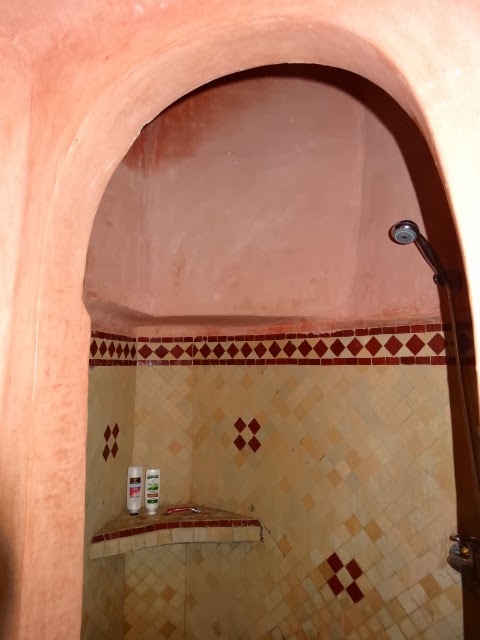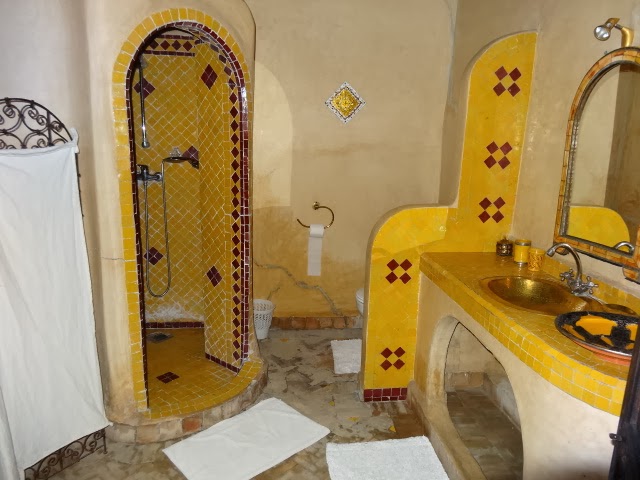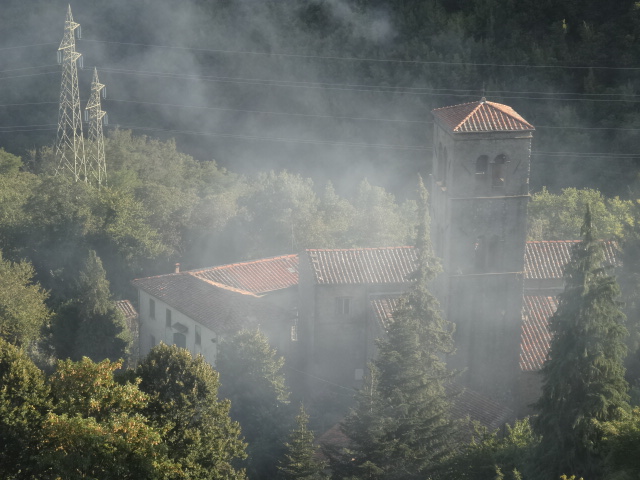For those who didn’t have an opportunity to read yesterday’s post, we will be posting a photo from our post of the same day and month, one year ago, at the bottom of each new post, including the link to the older post. This is intended to assist new readers in catching up, if those so choose, if they’d prefer not to scroll through the archives listed on the right side of each daily post.
 |
| A lily pad in a pond in Jardin Marjorelle, a major tourist attraction in Marrakech which we visited on Monday. |
 |
| These turtles lined up in a row made us laugh.It appeared there were different varieties based on their shells. |
 |
| These two were away from the group. Perhaps, a mom and a baby? |
Yesterday, Adil came to Dar Aicha to walk us to Mohamed’s taxi. The complex system of the souk and narrow roads and the fact that taxis generally aren’t allowed in the Big Square made planning a pre-arranged spot to meet tricky for us to find on our own. Mohamed was waiting for us in the square in an area designated for certain taxis.
 |
| Tom, shortly after we entered Jardin Marjorelle. Visiting a garden if not his first choice of activity, preferring to experience interesting vegetation in its natural habitat. I totally agree with him, but was anxious to take some photos. |
 |
| A guide offered to take our photo in this sunny spot. |
Taking shortcuts through the souk that we had no idea existed, made the 10-minute fast-trek through the maze-like streets interesting. Adil’s enthusiastic pace made it impossible to stop for photos along the way. Tom, with his excellent sense of direction, feels confident that he can find that path again enabling me to take photos.
 |
| Although not the season for flowers blooming, we noticed a few as we strolled through the garden. |
 |
| There were several bougainvillea trees in the garden. |
 |
| With tourists at my elbow, it was challenging having ample room to get quality shots. |
After a 20 minute stop at a pharmacy outside the Big Square for a medication issue, we’ll describe in Thursday’s post, revolving around, “Oh, it’s hell to get old” and “The trials and tribulations of taking prescribed medication while traveling the world.” Back to that later.
 |
| Cactus that appears as a flower. |
 |
| This bright blue was used in the theme throughout the garden. |
After the pharmacy visit, we were on our way to the first sightseeing stop, Jardin Marjorelle. Riding in good driver Mohamed’s new white SUV in air-conditioned comfort added to the experience. Samir was also in attendance, as our guide, with Mohamed speaking little English.
 |
| A Koi pond contained several fish. |
 |
| Symmetry attracts our eye. |
 |
| These flowers appeared to be in the snapdragon family. |
Jardin Marjorelle is one of the most visited tourist attractions in Marrakech. Intrigued with vegetation, I particularly enjoyed viewing the extensive displays of plants and trees beautifully presented in the garden.
 |
| This cactus reminded us of a common variety we’ve seen in the US. |
 |
| Interesting groupings. |
As much as we would have preferred to identify each of the plants and trees by name as we share these photos, it would have required a more lengthy visit when many of the signs describing the varieties were confusing and difficult to decipher with the crowds at our elbows as we shot the photos. We had no choice but to move along to allow others to take their photos.
 |
| The blooms on the various cacti are of particular interest. |
 |
| Curly cactus. |
 |
| Ouch! |
We have included a link here should you care to search for a particular plant, many of which were cactus. With the cool winter weather and hot summers, certain varieties of cactus do grow in Morocco. However, many of those displayed were imported from other parts of the world with a more consistent year-round hot dry climate.
 |
| Fuzzy cactus. |
 |
| Tall cactus. |
 |
| The blooms often appear as an anomaly. |
Most of the sights described for Marrakech in this link include much of what we’ll see when we take a few day trips outside the city mid-April. The remaining tourist attractions include palaces and old buildings, some of which we’ll tour at a later date and share here. As previously mentioned, the mosques do not allow non-Muslim visitors.
 |
| It’s interesting how cactus produce their self-defense system. |
 |
| More eye-appealing symmetry. |
 |
| The blooms reminded us of miniature pineapples. |
After having walked literally every path in the garden, we commenced our tour in the Yves St. Laurent and Pierre Berge display pavilion, who’d purchased the garden in 1980 to save it from being destroyed for the building of high rise buildings. Their dedication and devotion to this art-centered garden are illustrated in some of the photos we’ll share here today.
 |
| Although the sun was behind this, we were fascinated with these protrusions. |
With a little time to spare we made our way to the pre-arranged location where we’d find Mohamed and Samir ready to take us to a drive through the new city, the upscale Palmeraie area as shown in this map:
 |
| This map illustrates the various areas of Marrakech, each with its own unique personality. |
The following is a quote from this website, explaining the Palmeraie area of Marrakech:
“The Palm Grove quarter: extravagant villas and jet-set parties
It’s the neighborhood of billionaires and show-business movie stars but there are also a number of vacation clubs (ClubMed.) and wonderful guesthouses combining 1001 nights decors and sweet lifestyle (most of these villas have magnificent pools).
It should however be noted that the Marrakech palm grove covers an area between 8 and 12 miles from downtown and that commuting may therefore quickly be a major concern – and a major budget item. Staying in the palm grove of Marrakech is not necessarily the best choice if your priority is to explore the city. Conversely, it can be a great choice if you are a golfer and intend to devote most of your stay in this sport. In all cases, it will be necessary to ensure the hotel policy about transfers and shuttles to and from downtown.”
 |
| An odd formation, leaning toward the ground. |
 |
| Bumping into this cactus would be painful! |
 |
| Peculiar shapes. |
The hour-long drive through the area was particularly interesting after spending most of our time in the old walled city, the Medina. It gave us an entirely different perspective of Marrakech as a progressive modern city appealing to travelers seeking a more modern environment and yet still being in close proximity to the excitement and charm of the renowned souks and old city.
 |
| Perhaps, one’s individual preference in cactus could reveal something about our personalities. Tom and I both were attracted to the symmetrical shapes. |
Samir pointed to various walled homes and exquisite compounds owned by dignitaries and celebrities from all over the world. Three beautiful golf courses are a major draw to world travelers with upscale hotels, condos, and houses surrounding them.
 |
| Fuzzy, large grouping. |
 |
| Various varieties grouped together. |
 |
| These almost looked like cherry blossoms one might see in the east coast of the US at this time of year. |
Throughout the Palmeraie area, there were numerous herds of camels on the main road. The camels, owned by various vendors, were for hire for tourists to ride through the executive residential area.
 |
| The blooms filled a large area. |
We were especially excited to have the opportunity to stop to see a herd of camels owned by a friend of Samir’s that freely allowed us to take photos.
 |
| The Yves St. Laurent pavilion had many of his works of art. |
 |
| More art on display in the pavilion. |
 |
| This area was crowded making photo taking difficult. |
 |
| As we departed Jardin Majorelle, we took this final photo. The cost for two to enter the garden is US $12.31, MAD $100, well worth the expenditure. |
Part 2, tomorrow…please check back!
____________________________________________
Photo from one year ago today, March 25, 2013:
 |
| Although this wasn’t our photo, we’d posted this one year ago after a tourist had been stung by a stingray at the beach in front of our home in Belize. We’d seen plenty of these in the water during our long walks along the beach during our over two months on Belize. Their presence did have an impact on our desire to swim in the ocean resulting in our spending time at the pool each day. The injured tourist was taken to a local medical clinic provided care for the tourist and she recovered within a few days. There is no antitoxin for a stingray attack. Here is the link to last year’s post. |






































































































































































